NCERT Class 12 Biology Chapter 3 Human Reproduction Solutions to each chapter is provided in the list so that you can easily browse through different chapters NCERT Class 12 Biology Chapter 3 Human Reproduction and select need one. NCERT Class 12 Biology Chapter 3 Human Reproduction Question Answers Download PDF. NCERT Biology Class 12 Solutions.
NCERT Class 12 Biology Chapter 3 Human Reproduction
Also, you can read the NCERT book online in these sections Solutions by Expert Teachers as per Central Board of Secondary Education (CBSE) Book guidelines. CBSE Class 12 Biology Solutions are part of All Subject Solutions. Here we have given NCERT Class 12 Biology Chapter 3 Human Reproduction Notes, NCERT Class 12 Biology Textbook Solutions for All Chapters, You can practice these here.
Human Reproduction
Chapter: 3
BIOLOGY
UNIT – I REPRODUCTION
TEXT BOOK QUESTIONS ANSWERS
Q. 1. Fill in the blanks:
(a) Humans reproduce ____________. (asexually/sexually)
Ans: sexually.
(b) Humans are ____________. (oviparous/
viviparous/ovoviviparous)
Ans: viviparous.
(c) Fertilization is ____________ in humans. (external/internal)
Ans: internal.
(d) Male and female gametes are ____________. (diploid/haploid)
Ans: haploid.
(e) Zygote is _________ (diploid/haploid)
Ans: (e) diploid.
(f) The process of release of the ovum from a mature follicle is called ____________.
Ans: ovulation.
(g) Ovulation is induced by a hormone called the ____________.
Ans: luteinizing hormone.
(h) The fusion of the male and the female gametes is called ____________.
Ans: fertilization.
(i) Fertilization takes place in the ____________.
Ans: fallopian tube.
(j) The zygote divides to form ____________ which is implanted in uterus.
Ans: blastocyst.
(k) The structure which provides vascular connection between the fetus and uterus is called ____________.
Ans: placenta.
Q. 2. Draw a labeled diagram of male reproductive system.
Ans:
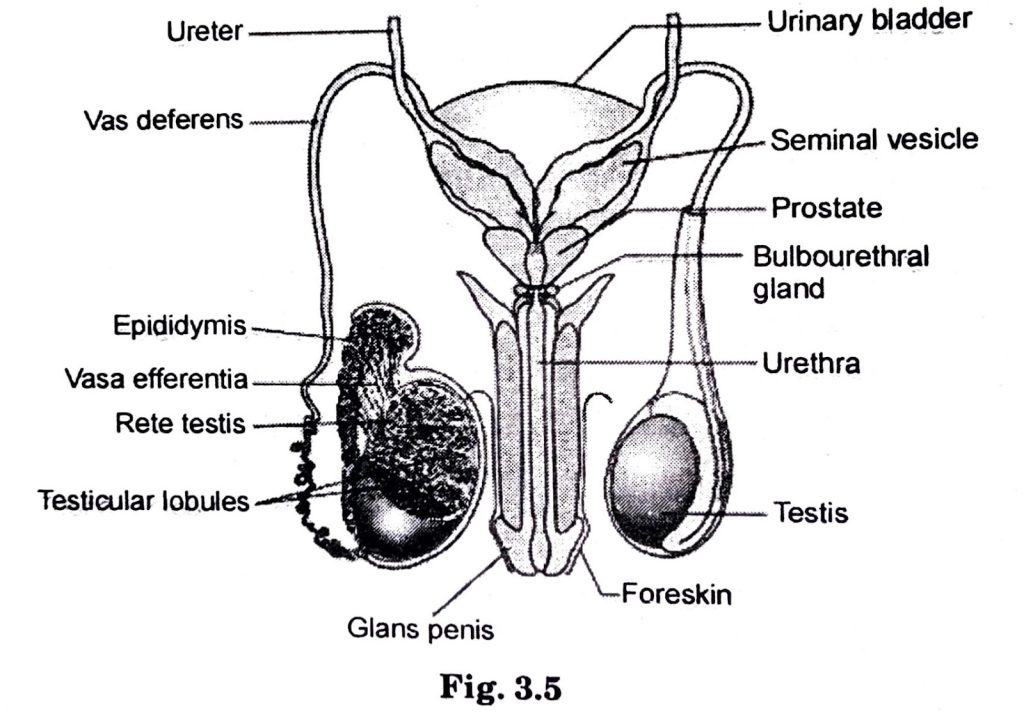
Q. 3. Draw a labeled diagram of female reproductive system.
Ans.
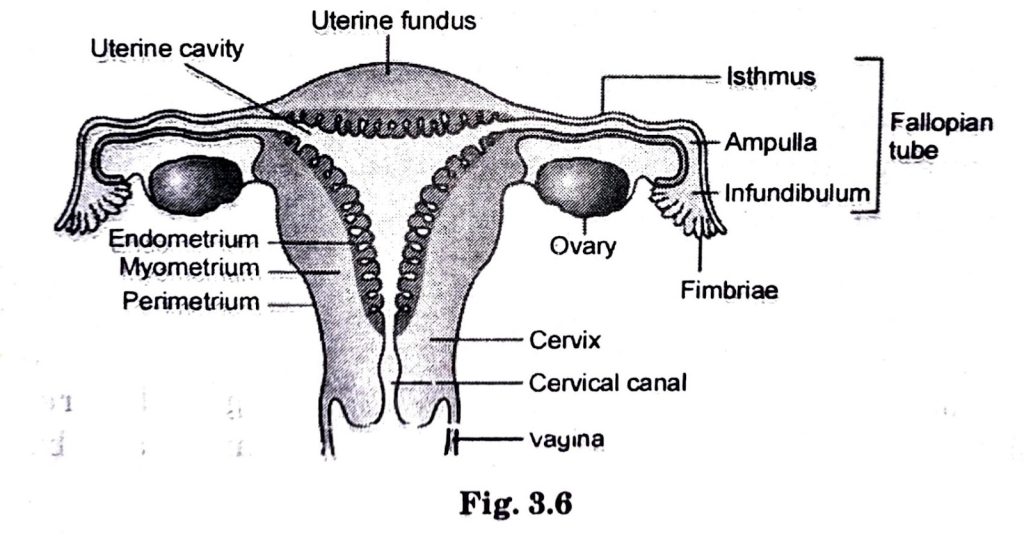
Q. 4. Write two major functions each of testis and ovary.
Ans: Functions of the Testis: They produce male gametes called spermatozoa. Leydig cells of the seminiferous tubules secrete the male sex hormone called testosterone. Functions of the ovary: They produce female gametes called ova. Graffian follicles secrete the female sex hormone called estrogen.
Q. 5. Describe the structure of a seminiferous tubule.
Ans: Highly coiled structure called seminiferous tubules are located in testicular lobules. Each seminiferous tubule is lined by germinal epithelium. It is lined on its inner side by two types of cells: spermatogonia and sertoli cells. Spermatogonia are male germ cells which undergo meiotic divisions to form spermatozoa. Sertoli cells provide nutrition to the germ cells. Large polygonal cells called interstitial cells or leydig cells lie just adjacent to seminiferous tubules. These cells synthesize and secrete male hormone called testosterone.
Q. 6. What is spermatogenesis? Briefly describe the process of spermatogenesis.
Ans: Spermatogenesis is the process of production of sperms from immature germ cells in males. It takes place in seminiferous tubules. During spermatogenesis, a diploid spermatogonium (male germ cell) divide by mitosis and form diploid primary spermatocyte. Primary spermatocyte undergoes first meiotic division (meiosis I) to form two haploid secondary spermatocytes. Each secondary spermatocyte undergoes second meiotic division (meiosis II) to form two haploid spermatids. Hence, a diploid spermatogonium produces four haploid spermatids. Spermatids are transformed into spermatozoa (sperm) by process called spermiogenesis.
Q. 7. Name the hormones involved in regulation of spermatogenesis.
Ans: FSH, LH and testosterone.
Q. 8. Define spermiogenesis and spermiation.
Ans: Spermiogenesis: It is the process of transforming spermatids into matured spermatozoa.
Spermiation: It is the process when mature spermatozoa are released from the sertoli cells into the lumen of seminiferous tubules.
Q. 9. Draw a labeled diagram of sperm.
Ans:
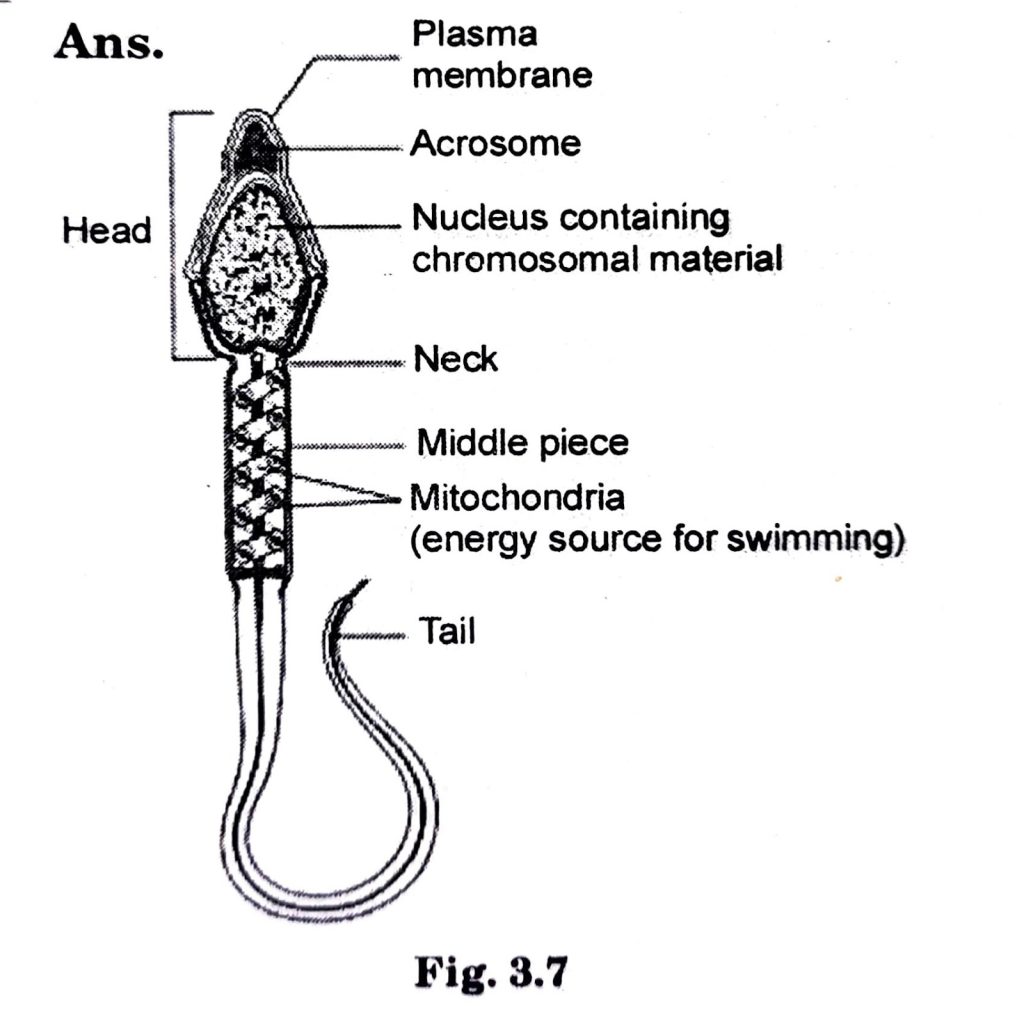
Q. 10. What are the major components of seminal plasma?
Ans: The major components of the seminal plasma are secretions of accessory glands. The seminal plasma is rich in fructose, calcium, ascorbic acid, and certain enzymes.
Q. 11. What are the major functions of male accessory ducts and glands?
Ans: Male accessory ducts are vasa efferentia, epididymis, vas deferens, and rete testis. They transport and store sperms. Male accessory glands are seminal vesicles, prostate glands, and bulbourethral glands.
These glands secretion lubricate the reproductive system and provide nutrients to the sperm.
Q. 12. What is oogenesis? Give a brief account of oogenesis.
Ans: Oogenesis is the process of the formation of a mature ovum from oogonia in females. It takes place in the ovaries. During oogenesis, a diploid oogonium or egg mother cell forms diploid primary oocyte. Primary oocyte undergoes first meiotic division i.e. meiosis I or reductional division to form haploid smaller cell known as first polar body and larger cell known as secondary oocyte.
Secondary oocyte undergoes second meiotic division i.e. meiosis II or equational division and gives rise to second polar body and ovum. Hence, diploid oogonium produces a single haploid ovum and two or three polar bodies.
Q. 13. Draw a labeled diagram of a section through ovary.
Ans:
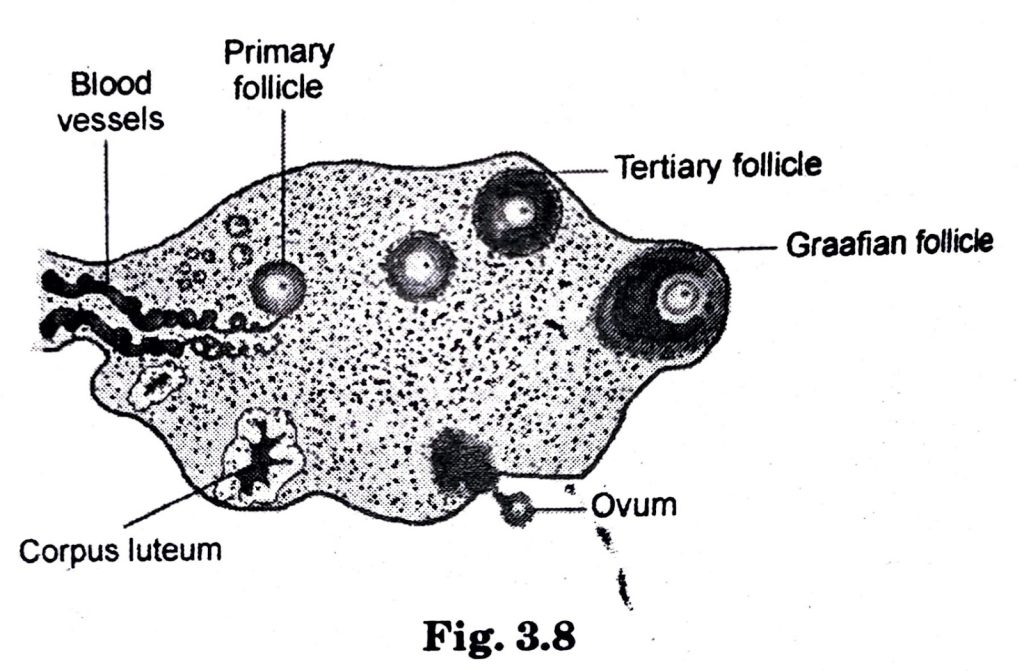
14. Draw a labeled diagram of a Graafian Follicle?
Ans.
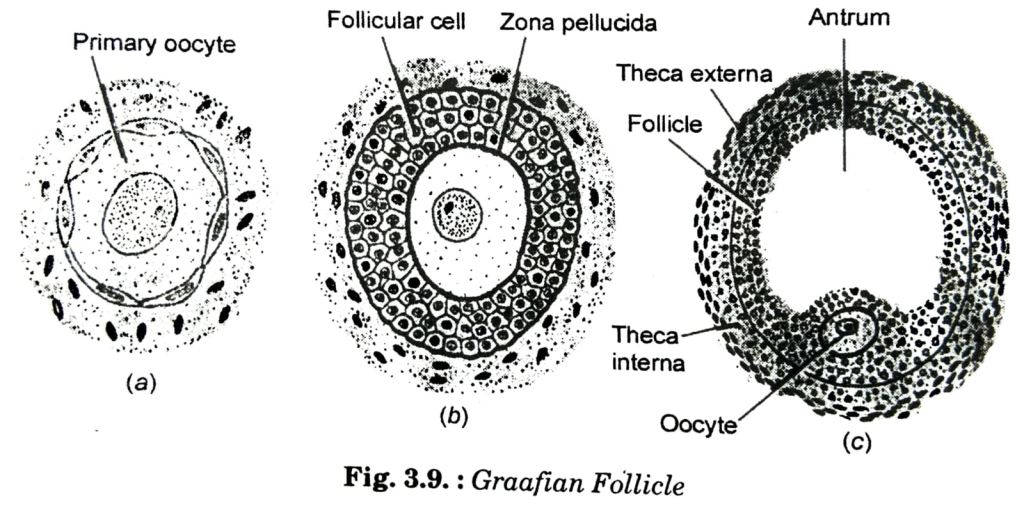
Q. 15. Name the functions of the following:
(a) Corpus luteum.
Ans: Corpus luteum: It secretes progesterone hormone during the luteal phase of menstrual cycle. Progesterone inhibits secretions of FSH and LH, thereby prevents ovulation. It causes endometrium to proliferate and prepare for implantation.
(b) Endometrium.
Ans: Endometrium: It is the innermost lining of the uterus. It undergoes cyclic changes during menstrual cycle.
(c) Acrosome.
Ans: Acrosome: It contains hyaluronidase enzyme, which hydrolyses outer membrane of egg and helps sperm to penetrate the egg at the time of fertilization.
(d) Sperm tail.
Ans: Sperm tail: It causes movement of the sperm inside the female reproductive tract.
(e) Fimbriae.
Ans: Fimbriae: They help in the collection of ovum after ovulation.
Q. 16. Identify True/False statements. Correct each false statement to make it true.
(a) Androgens are produced by Sertoli cells. (True/False
Ans: False.
(b) Spermatozoa get nutrition from Sertoli cells. (True/False)
Ans: True.
(c) Leydig cells are found in ovary. (True/False)
Ans: False.
(d) Leydig cells synthesize androgens. (True/False)
Ans: True.
(e) Oogenesis takes place in corpus luteum. (True/False)
Ans: False.
(f) Menstrual cycle ceases during pregnancy. (True/False)
Ans: True.
(g) Presence or absence of hymen is not a reliable indicator of virginity or sexual experience. (True/False)
Ans: True.
Q. 17. What is menstrual cycle? Which hormones regulate menstrual cycle?
Ans: The reproductive cycle in the female primates e.g. monkeys, apes, human beings is called menstrual cycle. Cycle of events starting from one menstruation till the next one is called the menstrual cycle. Menstruation is repeated at an average interval of about 28/29 days. One ovum is released during ovulation in one menstrual cycle. Menstrual cycle has four phases: menstrual, proliferative, ovulatory and secretory phase. Follicle stimulating hormone (FSH), luteinizing hormone (LH), estrogen, and progesterone are the hormones that regulate menstrual cycle.
Q. 18. What is parturition? Which hormones are involved in induction of parturition?
Ans: Delivery of the fetus (childbirth) due to vigorous uterine contractions at the end of pregnancy is called parturition. Hormones involved in this process are oxytocin and relaxin.
Q. 19. In our society the women are often blamed for giving birth to daughters. Can you explain why this is not correct?
Ans: Sex is determined by the type of male gamete (X or Y) which fuses with the X chromosome of female. If the fertilizing sperm is X, then the baby will be girl and if it is Y, then the baby will be boy. Therefore, it is incorrect to blame a woman for giving birth to daughters.
Q. 20. How many eggs are released by a human ovary in a month? How many eggs do you think would have been released if the mother gave birth to identical twins? Would your answer change if the twins born were fraternal?
Ans: An ovary releases an egg every month. Identical twins are produced from single egg by the cleavage. Fraternal twins develop from two separate eggs.
Q. 21. How many eggs do you think were released by the ovary of a female dog which gave birth to 6 puppies ?
Ans: Female dogs have multiple ovulation i.e. more than one ovum is released from the ovary at the time of ovulation. Hence, six eggs were released by the ovary of a female dog to produce six puppies.

Hi! my Name is Parimal Roy. I have completed my Bachelor’s degree in Philosophy (B.A.) from Silapathar General College. Currently, I am working as an HR Manager at Dev Library. It is a website that provides study materials for students from Class 3 to 12, including SCERT and NCERT notes. It also offers resources for BA, B.Com, B.Sc, and Computer Science, along with postgraduate notes. Besides study materials, the website has novels, eBooks, health and finance articles, biographies, quotes, and more.



